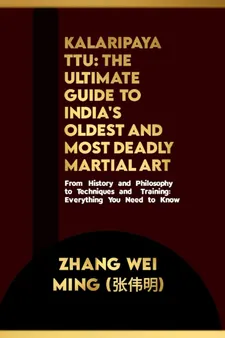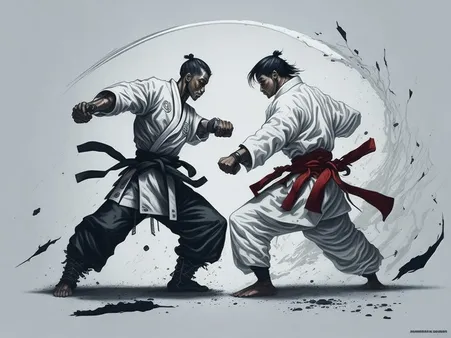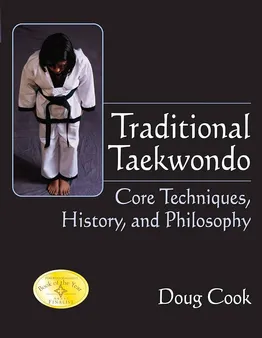Table of Contents
In the realm of combat and self-defense, martial arts stand tall as a testament to human adaptability, discipline, and the pursuit of personal excellence. The history and philosophy of martial arts paint a rich tapestry of cultural heritage, philosophical insights, and practical techniques that have captivated practitioners for centuries. At Kizworld, we embark on a journey through the evolution and essence of martial arts, exploring the intricate interplay between techniques, forms, and the profound philosophies that underpin them.
The History and Philosophy of Martial Arts: A Journey of Self-Discovery and Empowerment
I. Historical roots of martial arts: Tracing the origins of combat techniques across cultures
Historical roots of martial arts: Tracing the origins of combat techniques across cultures
The East Asian Legacy: A Cradle of Martial Arts
In the annals of martial arts, East Asia stands as a venerable cradle of combat techniques. From the ancient battlefields of China to the serene temples of Japan, a rich tapestry of martial arts traditions has emerged, each with its unique philosophies and practices. Kung Fu, with its diverse styles and emphasis on internal energy, has captivated practitioners for centuries. Karate, known for its powerful strikes and dynamic movements, has gained worldwide recognition. Taekwondo, characterized by its lightning-fast kicks and fluid forms, has become a symbol of Korean martial arts prowess. These are but a few examples of the many martial arts that have originated in East Asia, each contributing to the region's profound martial heritage.
- The History and Evolution of Gymnastics
- The Benefits of Gymnastics for Kids
- The Best Gymnastics Equipment for Home Use
The Martial Arts of Southeast Asia: A Blend of Tradition and Innovation
Southeast Asia, a region of diverse cultures and landscapes, has also played a significant role in the development of martial arts. From the graceful movements of Silat, practiced in Indonesia and Malaysia, to the fierce techniques of Muay Thai, Thailand's national sport, the martial arts of Southeast Asia reflect the region's rich history and cultural heritage. These martial arts often incorporate elements of dance, music, and spirituality, creating a unique blend of tradition and innovation.
Martial Art | Origin | Key Characteristics |
|---|---|---|
Silat | Indonesia, Malaysia | Graceful movements, fluid transitions, and a focus on self-defense |
Muay Thai | Thailand | Powerful strikes, devastating kicks, and a strong emphasis on clinch work |
Pencak Silat | Indonesia | A combination of Silat and traditional Indonesian martial arts, known for its dynamic footwork and intricate hand techniques |
The Martial Arts of South Asia: A Journey of Self-Discovery
In the vibrant lands of South Asia, martial arts have taken on a profound spiritual and philosophical dimension. Kalaripayattu, an ancient martial art from Kerala, India, is believed to have originated over 3,000 years ago. It emphasizes physical conditioning, mental focus, and the development of inner strength. Gatka, a martial art from the Punjab region of India, is known for its use of wooden sticks and its emphasis on discipline and self-control. These martial arts are not merely combat systems; they are pathways to self-discovery and personal transformation.
II. Martial arts philosophy: Unveiling the principles, values, and ethics that guide martial arts practice
Martial arts philosophy: Unveiling the principles, values, and ethics that guide martial arts practice
The Essence of Martial Arts: A Journey of Self-Discovery and Personal Growth
At the heart of martial arts lies a profound philosophy that transcends mere physical techniques. It is a way of life that emphasizes self-discipline, respect, and the pursuit of personal excellence. This philosophy shapes the values and ethics that guide martial arts practitioners, both on and off the mat. By delving into the core principles of martial arts philosophy, we uncover a rich tapestry of wisdom that has stood the test of time.
Martial arts philosophy is deeply rooted in the concept of self-awareness and self-control. Practitioners are taught to cultivate a keen understanding of their own strengths and weaknesses, both physical and mental. This self-awareness allows them to make informed decisions in the heat of battle, adapting their techniques to the situation at hand. It also fosters a sense of humility and respect for others, as practitioners recognize that there is always more to learn and that no one is perfect.
The Importance of Respect and Honor in Martial Arts
Respect is a cornerstone of martial arts philosophy. Practitioners are taught to respect their teachers, fellow students, and opponents, regardless of their skill level or background. This respect extends beyond the dojo walls, as martial artists are expected to conduct themselves with honor and integrity in all aspects of their lives. They are taught to avoid violence and aggression, and to use their skills only in self-defense or to protect others.
The pursuit of personal excellence is another key aspect of martial arts philosophy. Practitioners are encouraged to constantly strive to improve their skills and knowledge, both in martial arts and in other areas of their lives. This pursuit of excellence is not about achieving perfection, but rather about the journey itself. It is about setting goals, working hard, and never giving up, even in the face of setbacks.
- Respect for oneself and others
- Honesty and integrity
- Courage and perseverance
- Self-discipline and self-control
- Humility and modesty
The Role of Martial Arts in Modern Society
In today's fast-paced and often stressful world, martial arts can provide a much-needed outlet for physical and mental well-being. Practicing martial arts can help to reduce stress, improve focus and concentration, and boost self-confidence. It can also teach valuable life skills, such as teamwork, cooperation, and conflict resolution.
Martial arts can also be a powerful tool for personal empowerment, especially for women and marginalized groups. By learning self-defense techniques, individuals can gain the confidence and skills they need to protect themselves from harm. Martial arts can also help to break down stereotypes and promote inclusivity, as people from all walks of life come together to train and learn from one another.
Physical Benefits | Mental Benefits |
Improved cardiovascular health | Increased self-confidence |
Enhanced strength and flexibility | Improved focus and concentration |
Reduced stress and anxiety | Greater self-discipline |
Improved balance and coordination | Enhanced problem-solving skills |
Increased energy levels | Boosted creativity |
Preserving and Promoting Martial Arts for Future Generations
As martial arts continue to evolve and adapt to the changing needs of society, it is important to preserve and promote the traditional values and principles that have made them so enduring. This can be done through the establishment of martial arts schools and academies, the organization of tournaments and competitions, and the creation of educational programs that teach the history, philosophy, and techniques of martial arts.
By passing on the traditions and teachings of martial arts to future generations, we can ensure that this valuable cultural heritage continues to thrive and inspire people around the world. Martial arts can be a powerful force for good in the world, promoting peace, understanding, and respect among all people.
How to Choose the Right Martial Art for YouThe Benefits of Martial Arts for Physical and Mental HealthThe Best Martial Arts Equipment and Gear
III. The Evolution of Martial Arts: Exploring the Transformation of Fighting Techniques Throughout History
The history of martial arts is a captivating journey through diverse cultures, philosophies, and combat techniques. From ancient civilizations to modern times, martial arts have evolved to reflect the needs and values of societies worldwide. In this section, we delve into the fascinating evolution of martial arts, tracing the transformation of fighting techniques across different eras and regions.
The earliest forms of martial arts can be traced back to prehistoric times, where humans developed basic self-defense skills for survival. As civilizations emerged, these rudimentary techniques were refined and systematized, giving rise to distinct martial arts styles. In ancient Greece, pankration, a brutal combination of wrestling and boxing, was a popular sport in the Olympic Games. In China, the development of kung fu encompassed various styles, each emphasizing different principles and techniques.
Martial Art | Origin | Key Techniques |
|---|---|---|
Kung Fu | China | Striking, grappling, and weapon-based techniques |
Karate | Japan | Powerful strikes, kicks, and blocks |
Taekwondo | Korea | Dynamic kicks, punches, and hand strikes |
Muay Thai | Thailand | Devastating strikes using fists, elbows, knees, and shins |
Capoeira | Brazil | A blend of martial arts, dance, and acrobatics |
As martial arts spread across continents, they underwent adaptations and modifications to suit local conditions and cultural influences. In Japan, the samurai developed a range of martial arts, including jujutsu, kendo, and aikido, emphasizing self-defense and combat efficiency. In Southeast Asia, martial arts like Muay Thai and Silat emerged, known for their devastating striking techniques and close-quarters combat.
The 20th century witnessed a surge of interest in martial arts globally. The popularity of Bruce Lee, a renowned martial artist and actor, introduced kung fu to a worldwide audience. Other martial arts, such as karate, taekwondo, and judo, gained recognition through international competitions and demonstrations. Today, martial arts are practiced by millions of people worldwide, not only for self-defense but also for fitness, discipline, and personal development.
The evolution of martial arts is a testament to human ingenuity and adaptability. From ancient self-defense techniques to modern combat sports, martial arts have continuously evolved to reflect the changing needs and values of societies. As we explore the diverse world of martial arts, we gain insights into the rich cultural heritage and martial traditions that have shaped our world.
Whether you are a seasoned martial artist or a curious beginner, the history and philosophy of martial arts offer a wealth of knowledge and inspiration. Discover the transformative power of martial arts and embark on a journey of self-discovery, empowerment, and personal growth.
Explore our related articles to delve deeper into the fascinating world of martial arts:
- The Benefits of Martial Arts for Physical and Mental Health
- The Best Martial Arts Equipment and Gear
- How to Improve Your Speed, Power, and Agility with Martial Arts
- The Most Common Martial Arts Injuries and How to Treat Them
- The Best Martial Arts Apps and Websites
IV. The Cultural Impact of Martial Arts: Examining the Influence of Martial Arts on Society, Arts, and Popular Culture
The cultural impact of martial arts extends far beyond the physical realm of self-defense and combat. Throughout history, martial arts have profoundly influenced various aspects of society, arts, and popular culture, leaving an indelible mark on human civilization. From ancient traditions to modern-day practices, martial arts have shaped values, beliefs, and artistic expressions across the globe.
One of the most significant ways martial arts have influenced society is through the promotion of physical and mental well-being. The rigorous training and disciplined practice of martial arts techniques not only enhance physical fitness and coordination but also cultivate mental focus, self-control, and resilience. These qualities have been instrumental in shaping the character and outlook of countless individuals, fostering a sense of empowerment and self-confidence.
Martial Arts | Benefits |
|---|---|
Physical Fitness | Improved strength, flexibility, and coordination |
Mental Focus | Enhanced concentration and mindfulness |
Self-Control | Greater emotional regulation and impulse control |
Resilience | Increased ability to cope with stress and adversity |
Martial arts have also played a pivotal role in the development of various art forms, including literature, film, and music. The captivating narratives and larger-than-life characters found in martial arts stories have inspired countless works of fiction, captivating audiences with their tales of heroism, honor, and redemption. Martial arts films, with their visually stunning fight scenes and intricate choreography, have become a beloved genre, showcasing the athleticism and artistry of martial arts practitioners.
In the realm of music, martial arts have influenced the creation of powerful and evocative soundtracks that enhance the emotional impact of films and television shows. The rhythmic beats and melodic harmonies of these compositions perfectly complement the dynamic movements and intense action of martial arts sequences, heightening the viewer's engagement and immersion.
- Martial arts have influenced various art forms, including literature, film, and music.
- Martial arts stories have inspired countless works of fiction, captivating audiences with their tales of heroism, honor, and redemption.
- Martial arts films, with their visually stunning fight scenes and intricate choreography, have become a beloved genre, showcasing the athleticism and artistry of martial arts practitioners.
- Martial arts have influenced the creation of powerful and evocative soundtracks that enhance the emotional impact of films and television shows.
The cultural impact of martial arts is further evident in popular culture, where martial arts techniques, philosophies, and imagery have become ubiquitous. From video games and anime to fashion and advertising, martial arts have permeated various forms of media and entertainment, capturing the imagination of people worldwide. The popularity of martial arts-inspired merchandise, such as clothing, accessories, and home décor, reflects the widespread appeal and recognition of martial arts in contemporary society.
In conclusion, the cultural impact of martial arts is undeniable. From promoting physical and mental well-being to inspiring artistic expression and shaping popular culture, martial arts have left an indelible mark on human civilization. The values, beliefs, and practices of martial arts continue to resonate with people from all walks of life, fostering a sense of community and connection among those who share a passion for this ancient and enduring tradition.
V. Conclusion
Martial arts, with their rich history and profound philosophies, stand as a testament to human resilience, discipline, and the pursuit of personal growth. As we navigate the ever-changing landscape of modern society, the lessons and skills imparted by martial arts remain invaluable. Whether for self-defense, physical fitness, or spiritual enlightenment, martial arts empower individuals to face challenges with courage, grace, and unwavering determination. It is through the preservation and promotion of these ancient traditions that we honor the legacy of martial arts and ensure their continued relevance for generations to come.